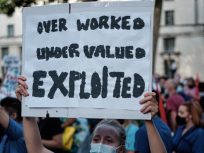Victor Narro is the Project Director for the UCLA Center for Labor Research and Education, and a lecturer at UCLA Law School and UCLA School of Urban Planning.
On September 8, the AFL-CIO will kick off its national convention in Los Angeles. The last time it was held in L.A. was in 1999, when the AFL-CIO announced its historic declaration for a legalization program for all undocumented immigrants, increased workplace protection for immigrant workers and an end to employer sanction laws, which it supported back in 1986 as part of the Immigration Reform and Control Act (IRCA). The national convention this year in LA will also be a historic one. With union density at around 12% (the private sector below 7%), the labor movement today is in a state of crisis. As the recent deep recession, or depression as some economists have labeled it, has shown us, the labor movement is really the only safety net that we have in this country for the working class.
The AFL-CIO leadership has responded with a strategy of moving forward with building a labor movement of inclusion and integration of partnerships with key sectors from social justice, immigrant rights and the worker center movements. The pre-convention and convention activities for the AFL-CIO Convention in September will focus on diversity, alliance building and the creation of strong solidarity to work together to transform and rebuild the labor movement. One key transformation that is moving forward and will be highlighted at the convention is the solidarity and partnership between the labor movement and worker centers.
Over the years as labor restructuring accelerated, unionism declined, and the major changes in demographics of low-wage workforce, a new type of civic organization emerged. Worker centers emerged to respond to the increasing exploitation of low-wage immigrant workers and persistent racism and xenophobia in labor markets and society in general. These worker centers are community-based organizations that represent new immigrants and low-wage workers, helping them to address workplace issues and creating a constituency in labor markets, political arenas, and the larger society. Worker centers do not focus exclusively on labor and employment—or on immigration issues. They are about something much bigger and much more visionary in that they see themselves as a movement. Today there around 230 worker centers throughout the country and five major worker center networks – National Day Laborers Organizing Network (NDLON), National Domestic Workers Alliance (NDWA), Restaurant Opportunities Center United (ROC), National Guestworker Alliance, Food Chain Workers Alliance , and National Taxi Workers Alliance. A few years ago, these worker center networks have joined national worker advocacy groups like Jobs with Justice to create the United Workers Congress.
During the summer of 2006, a delegation from the AFL-CIO came to Los Angeles to meet with NDLON, which took them to the Agoura Hills day labor site, where the union officials watched the day laborers deciding whether to increase the minimum wage at the corner from $12 to $15. When eighty-five out of 100 day laborers raised their hands to increase the minimum, the AFL-CIO officials said “that’s how the unions began!” Discussions about a formal affiliation began as the two sides realized the benefits of needing one another. The AFL-CIO was moved by a desire to build support among immigrant workers. They were interested in connecting the growing worker center movement with organized labor. For NDLON, the motivation was to create a strong political alliance that would enable them to further protect the rights of day laborers, who at that time were the main targets on local, state and federal levels of anti-immigrant groups. NDLON realized that the AFL-CIO could become a formidable political ally in its efforts to influence the immigration reform debate so that day laborers are not left out of any reform policy or singled out for attacks. Furthermore, NDLON believed that in time the relationship with the AFL-CIO could be deepened with unions on local levels where day laborers can benefit from construction apprenticeship programs and become union members themselves. The AFL-CIO felt that a national partnership agreement with NDLON would be the best starting point to launch its new initiative known as the AFL-CIO National Worker Center Partnership. Since then, the AFL-CIO has forged a partnership with the other worker center networks. This partnership would also benefit AFL-CIO unions and local labor bodies by establishing channels to formally connect with local worker centers in order to expose abuses and improve workplace standards in various industries to the benefit of all workers. Under this partnership, worker centers would be able to join the local central labor councils of the AFL-CIO through a solidarity membership process.
In the six years since the AFL-CIO Executive Council approved the National Worker Center Partnership, a number of worker center affiliations into central labor councils or state labor federations have taken place around the country. The AFL-CIO has issued sixteen certificates of affiliation to date, and there have been no requests for revocation. These affiliations have taken place in 16 cities in 11 states.
Another great outcome of this partnership has been the CLEAN Carwash Campaign. Because of the increasing levels of collaboration and trust that the partnership developed between a number of Los Angeles area worker centers and local unions, community groups approached the AFL-CIO and asked if, together with a union affiliate, the Federation would partner with the community in efforts to improve conditions in the industry. The Steelworkers stepped up, with USW President Leo Gerard highly committed to reaching out to immigrant workers in an industry that has never been organized into a union. Together with the AFL-CIO and approximately 25 Los Angeles worker centers and other community organizations, an extremely encouraging partnership emerged to create this innovative campaign. Today, there are three carwashes with union contracts in LA and union organizing of carwash workers has spread to New York City and Chicago.
Today, the AFL-CIO leadership is working with worker center leaders to pave the way for the adoption of a resolution at the upcoming AFL-CIO Convention that would strengthen the worker center partnership by creating new opportunities for formal integrations of worker centers into the labor movement. Dialogue has focused on what the integration will look like and how the partnership will benefit worker centers with their growth and development as leading voices for low-wage workers.
Low-wage work is a growing sector of the economy and 25% of the labor market. The coordination between labor unions and worker centers is necessary to meet the growing need to organize new workforces and gain ground in industries that were once had high union density but have suffered declining union membership. Both worker centers and unions have the opportunity to benefit significantly from working jointly to achieve important victories. For collaboration to be effective, however, worker centers need significant investments from unions to help them become stronger and more self-sufficient. Unions need worker centers to forge new innovative ways of organizing workers in situations that fall outside the reach of the traditional model of collective bargaining. Unions and workers centers can combine to make a new type of labor movement a reality, and one that is needed to shift the paradigm from declining wages and deteriorating working conditions to workplace justice. This transformation will benefit all of us.
Follow Victor Narro on twitter @NarroVictor






Nice!
Thank you for your work in getting this information out!
No raises since the ’70s and an increase of 75% productivity in the last 20 yrs. – seems like a union/wrker ctr affiliation would not hurt to rebalance this equation. I do see some inequities: if the worker center( local) is not strong, the union (national) could usurp the W. Ctr’s goals. Aren’t the wrker ctrs like ROC United regional in effect?
Thanks again.
Chad you raise great points, and I will forward a piece I am working on that hopefully answer these concerns.